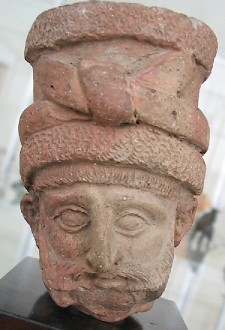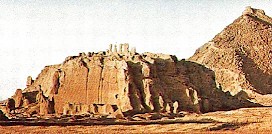Vivana

During the troubles after the death of the Persian king Cambyses (July 522 BCE), the pretender Vahyazdâta seized power in the heartland of the Achaemenid empire, Persis. He was powerful enough to appoint a satrap for the neighboring province Arachosia, the well watered country along the Helmand and Tarnak rivers in the southwest of modern Afghanistan. However, Arachosia was already ruled by another satrap, Vivâna, who had been appointed by king Cambyses (530-522) and was loyal to the deceased king's relative Darius I the Great.
In the Behistun inscription, we read what happened.
King Darius says: That Vahyazdâta, who called himself Smerdis, sent men to Arachosia against a Persian named Vivâna, my servant, the satrap of Arachosia. He appointed a certain man to be their leader, and thus he spoke to him, saying: 'Go smite Vivâna and the host which acknowledges king Darius!'
Then that army that Vahyazdâta had sent marched against Vivâna to give him battle. At a fortress called Kapiša-kaniš they fought the battle. Ahuramazda brought me help; by the grace of Ahuramazda my army utterly overthrew that rebel host. On the thirteenth day of the month Anâmaka was the battle fought by them.note

Kapiša-kaniš may be another name for Kapisa, the citadel of the capital of Arachosia, modern Kandahâr; it is also possible that it is identical to modern Begram, north of modern Kabul, but this seems to be a bit too far away. About the date we can be more precise: 29 December 522 BCE. We may assume that Vivâna was besieged for several weeks. It was not the end of the fighting, however.
King Darius says: The rebels assembled a second time and went out against Vivâna to give him battle. At a place called Gandutava they fought a battle. Ahuramazda brought me help; by the grace of Ahuramazda my army utterly overthrew that rebel host. On the seventh day of the month Viyaxana the battle was fought by them.
King Darius says: The man who was commander of that army that Vahyazdâta had sent forth against Vivâna fled thence with a few horsemen. They went to a fortress in Arachosia called Aršâdâ. Then Vivâna with the army marched after them on foot. There he seized him, and he slew the men who were his chief followers.
King Darius says: Then was the province mine. This is what was done by me in Arachosia.note
The location of this second battle is unknown; it may have been a bit more to the southwest, if we assume that Vivâna was now attacking his besiegers. The date was 21 February 521. According to the Babylonian version of the Behistun inscription, the army of Vahyazdâta's lieutenant lost 4.579 men.
The Elamite version of the inscription does not call Aršâdâ a fortress, but makes it clear that it was Vivâna's own domain. Is it possible that the enemy leader sought refuge in Vivâna's own home, and was executed by the owner before he was able to surrender?